page 10
Progressive Thinkers as of 5/8/2020
|
| ||||||||||||||||||||||||||||||||||||||||||||||||||||||||||||||||||||||||||||||||||||||||||||||||||||||||||||||||||||||||||||||||||||||||||||||||||||||
If the difference in chromosoome count came after the split between apes and more human-like creatures, then we might consider that the entire Homo- line had 46 chromosomes, including those hominids preceeding this category, such as the -pithecus line of descent (but not Circopithecus varities). Let us take a look at another primate group with respect to chromosome count:
Durukulis live in dry and wet tropical forests from Panama to Argentina. These monogamous monkeys, often in family groups of two to five individuals, can be seen with the fathers carrying the young. They sleep together in tree hollows during the day and emerge at night to feed on fruit, nectar, insects, and other small animals. Durukulis are fairly sedentary, and on moonlit nights they can be observed making soft clicks or chirrs, melodius whoops, and low hoots.
These primates belong to the family Cebidae, but species-level taxonomy is unclear in this genus, with as many as nine distinct and geographically disparate species recognized by some authorities. Taxonomy is further complicated by the fact that different populations have from 46 to 56 chromosomes. The monkeys, while fairly common, have not been heavily hunted, although they are in some demand as laboratory animals. (Durukuli, primate genus)
On this page: List of Chromosome count, we find the Rhesus monkey having 42 chromosomes, with its divergence from the line which future humans would come, occurring millions of years ago; and thus may signal to us a change in some unacknowledged "primate evolving principle" (PEP). This three-patterned phrase is coined distinct from but synonymous with the idea of cell type specification, though I had not come across the latter idea until after I had coined the idea. "PEP" is a specifically applied specification of the three generalities used as specificities. The idea of a "mosaic" looking structure in cellular development before differentiation into three Germ layers fromw which different body parts arise, is a word to which I have unknowingly subsituted with the word kaleidoscopic (and "kaleidoscopic array" phrase). Both words are clearly synonymous and means I have been thinking along similiar lines as others, albeit using a different vocabulary. But before providing a list of the three types (modes) of specification, let me provide a short background script. Though the comments are referring to cells, the same views can be generalized to overall species specificity, which helps to combat any consternations which might arixe when confronting a "mosaic" of chromosme counts not only in those life forms that are said to be distinct and not evolutionarily related, but those animals aligned in a tree diagram listing supposed primates. Whereas we have used particular criteria in establishing what we presently believe to be a family tree of primates connecting by an evolutionary-linkage, there are other specific criteria which can be presented to selectively dissasociate a given selection and present it as a separate consideration, despite other criteria being used as a type of "team member" designation and thus placed on a particular type of game roster. In the following reference, I am mentally altering the content to view different species as if they are different types of cells. Hence the three basic modes of cellular committment can apply to a given species in a given way, whereby even the whole membership of "primate family" can have certain individuals who are more closely related and act as twins (maternal/monozygotic or fraternal/dizygotic), triplets (monozygotic, dizygotic, trizygotic); as well as separate sibilings who may think and act alike and/or have the same interests, fears, dreams (ambitions), etc., though they otherwise appear different.
The following excerpt comes from here: The Developmental Mechanics of Cell Specification by by S.F. Gilbert
I will first present the information as it occurs, and then re-write it so that the reader can more clearly see how I am interpreting the information for the present context.
An embryo's environment may be a tide pool, a pond, or a uterus. As we saw above, the embryo interacts with its environment, and its developmental trajectory can be guided by information from its surroundings. On a smaller scale, the environment of an embryonic cell consists of the surrounding tissues within the embryo, and the fate of that cell (for instance, whether it becomes part of the skin or part of the lens) often depends upon its interactions with other components of its immediate "ecosystem."
A developing species' environment may be a tide pool, a pond, or a uterus. ...the species interacts with its environment, and its developmental trajectory can be guided by information from its surroundings. On a larger scale, the environment of a species consists of the surrounding elements and life forms within the living zone, and the fate of that species [or individual] (for instance, whether it remains part of the present community or part of some future descent) often depends upon its interactions with other components of its immediate "ecosystem," (which includes subtle, day-to-day and possible poignant changes in the immediate environmental surroundings such as food/water/shelter resources, as well as overall planetary activity from weather, to geological to planetary events.)
Evolution is an interesting topic, moreso (for me) when it is enumerated into types, kinds, tiers or whatever associated label is being used. For example:
Steve Gould’s Three Tiers of Evolution
- Microevolution: at the level of the individual.
- Macroevolution: at the level of species.
- Mass extinctions: at the level of whole faunas.
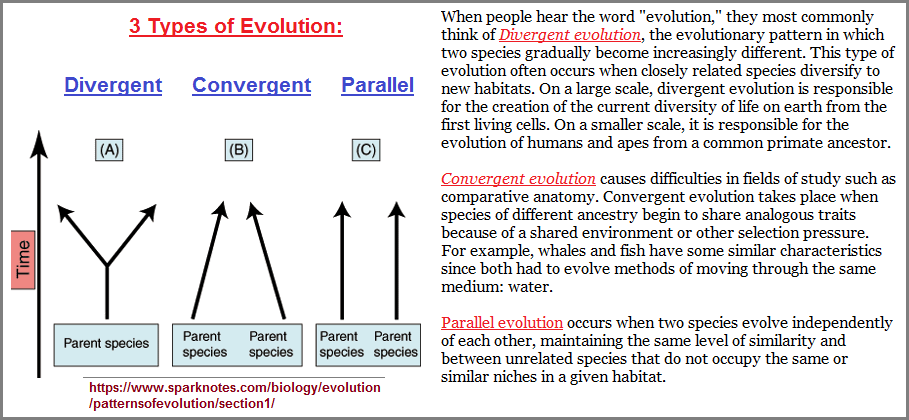
Within Evolution we find the topic of "spatial aspects" of speciation. Different resources may provide you with either 3, 4, or 5 collated items, (or even more, such as this account: There have been many patterns of speciation proposed including allopatric, sympatric, peripatric, parapatric, and saltational or centrifugal speciation: Speciation: controversy surrounding the origin and evolution of insects., though speciation is said to be placeable into three broad categories: allopatric, parapatric and sympatric):
- Allopatric: a physical barrier divides a continuous population
- Peripatric: a small founding population enters a new or isolated niche
- Parapatric: a new niche found adjacent to the original niche
- Sympatric: occurs without physical separation inside a continuous population (this is said to be controversial)
- Sympatric Speciation: Why the Controversy? by Chris D. Jiggins. The main reason why the debate over the role of geography in speciation has not been resolved is that distinguishing the alternatives in any particular case is extraordinarily difficult.
- What, if anything, is sympatric speciation? by B.M. Fitzpatrick, J.A. Fordyce, S. Gavrilets. Sympatric speciation has always fascinated evolutionary biologists, and for good reason; it pits diversifying selection directly against the tendency of sexual reproduction to homogenize populations. Sympatric speciation is of great interest to evolutionary biologists, in part because it has been consistently controversial since the inception of our field and in part because it challenges us to synthesize ecology, genetics and behaviour when attempting to understand how it might occur in nature.
- Artificial speciation: (Laboratory settings)
The above categories are reminiscent of sociological characterizations dealing with both groups and individuals within a community, government, religion, business, state, region, country, continent... and let us add planet, planetary system, galaxy, etc... They amount to different words being used to describe the same kinds of observations being made in different subjects, including sports events, games, gaming and other human interactions. It is like cellular activity is a microcosm of social activity played out with variations which mimic the same kinds of patterns in repetitive fashions.
If there is a connection between the tilt of the Earth and Chromosome count (even if only in certain contexts with or without variability), we need to discover to what extent (if any) such an occurrence exists, thus enabling us to possibly determine what is ahead of humanity in the future (if it survives its own business, political and religious nonsense). If the human primate linneage developed an overall 46 chromosome count by a mirror-image doubling effect caused by changes in polarization (such as those seen on smaller scales in chemistry), from an earlier primate account of 48 chromsomes living on an Earth with a axial tilt which exhibited a more prominant (sustained) 24 degrees; then this may not be the chromosomally expressed limit of influence, since treeshrews exibit a larger 62 chromosome count and came before the origination of chimps, orangutans and gorillas (a "small before large" sequencing of events). The degree of tilt along with the rate of the Earth's rotation coupled to polar reversals would not have had but a significant influence on those biological materials susceptible to such planetary/environmental "expressions". This is not to say all biological activity has a direct, easily discernible connection, since biological activity is suceptible to indirect influences as well... to an extent one might use the analogy of a butterfly effect, domino effect, echo or reverberation effect, etc... In addition, no doubt both the oxygenation and "snowball" Earth experiences might well be accounted for in such events... as well as continuing changes that would be more easily recognized if humanity was not contributing to so much environmental, cultural and other pollutions to perceptions... colloquially referred to as pollutions of the mind, and one might view Francis Bacon's four Idols (Tribe, Cave, Marketplace, Theater) as an earlier stated similarity. (They also look like types of sociologically described speciation.)
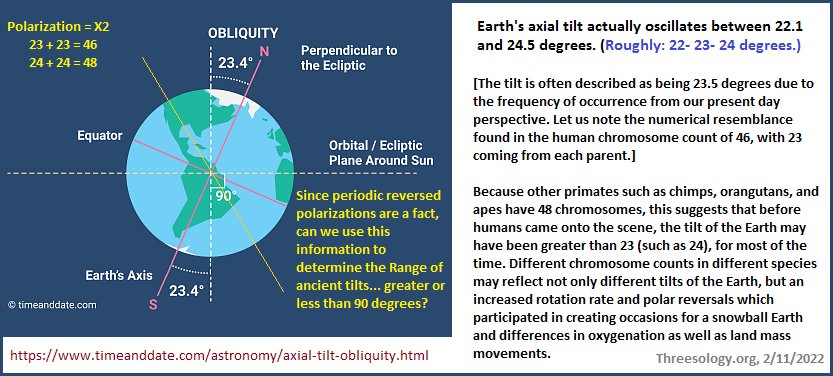
An organism exhibiting a larger or smaller chromosomal account (than 46 or 48) need not be viewed as a refutation of an Earth axial tilt connection, since its own linneage may exhibit characteristic alterations on a scale commensurate with the life form being examined. Because one life form is affected by environmental and;or planetary activity in a given way does not mean another life form will exhibit this same sort of account, yet may nonetheless exhibit a change that is specific to the life form being examined. Whereas one might think that an environmental response type by one organism should be identically seen in all other life forms, does not allow for species specificities consistent with their own physiolgical dispositions. Like different body parts arising from different germ layers, though the developing germ layers occur in the same cell, so too can this occur with different species inhabiting a similar environment. Since we have acknowledged that life forms can inhabit micro- and macro-specific environments in a seemingly similar or medial- ecosystem, so too can we apply this idea to the development of species in terms of criteria about planetary-patterned activities not customarily included in publicly offered documentation.
Whereas many reseachers note that there is a difference in chromosomal count between humans and their earlier born evolutionary cousins the chimps, orangutans and apes as well as accepting the determination that this difference is a result of a fusion of the number two chromosome, it is typically the case for these same researchers not to consider that this is due to some environmental event. They prefer to think in terms of some genetic event but not that the genetic event may have some readily observable environmental influence. However, when we look at all extant (living) life forms, it is found that in the animal realm, their exist those examples which have a greater than 48 chromosome count, which... is more than a 23 or 24 degree axial tilt, but is below the 360 degrees of a full one-revolution tilt of the Earth. This correlation is of course dependent on whether or not the axial tilt of the Earth has had any influence on chromosome number at all. However, whereas the tilt may have had an effect on the development of one species, it may not hold true for others. The reason(s) for this need to be worked out, just as other differences in life forms are being researched.
If we look at plants we find that the fern Ophiolglossum reticulatum has 1,440 (720 pairs) of chromosomes and the small creature called Oxytricha trifallax is said to have 16,000 (8,000 pairs) of chromosomes. The semiaquatic rodent Ichthyomys pittieri (Rodentia, Cricetinae) from Venezuela has a diploid chromosome number of 2n = 92, which is the highest value known for mammals. (On the highest chromosome number in mammals by M Schmid, A Fernández-Badillo, W Feichtinger, C Steinlein, J I Roman). Yet despite the large chromosomal counts which would at first appearance seem to dispute the idea that the axial tilt of the Earth's particular degress at a given time in history can have an effect on the developmental exegis of a given life form, it is thought that we need different equations for different life forms living in or developmentally arriving in different environments, be it aquatic or terrestrial.
While at first it appears that chromosome numbers greater than the total 360 degree tilt of the Earth at its possible (but not necessarily probable) maximum, we need to adopt a revision of our thinking in terms of axial tilt, geomagnetic reversals, land mass movements, positions on (or off) the Earth during development, Earth's rotation rate and in particular, re-examine our previous notions of dwarfism, normalcy, and gigantism. For example, whereas we note that dinosaurs and other creatures were rather large when compared to most creatures today, (though there are exceptions such as wales and perhaps the biblical Goliath might be included), we don't typically look at large numbers such as that found in chromosomal counts as expression of gigantism, or small counts as dwarfism, between which an approximate normal count might be labeled. In fact, the everyday U.S. three-patterned unenumerated sizing model of small- medium- large (as well as X-, XX- XXX- large... or even small, if one is willing to accommodate to such a view) may in some research cases provide some useful generality, just as the European sizing structure may prefer to use numerical references, and thus be inclined towards the usage of such because of cultural dispositions.
Clearly there are differences in perceptions as can be seen in the sizing differences of clothing, beverage drinks, electrical currents, etc., and whether or not such things as small- medium- large businesses, farms, schools, communities, armaments, food stockpiles, reserve military, etc., are being utilized, if even discussed as a socially useful option. The following image is a representative model of men's clothing size differences between the U.S. and European Union, though we could just as well extend the chart to include the thinking used in Asian and African countries, if they should appreciably differ. The point being is that such seemingly innoucous orientations may well have an undisclosed reflexive accounting method being used when looking at small- medium and large situations of different research material. In other words, depending on who is doing the interpreting of a given set of research data, we might well see an inclination for them to portray a method of accounting most familiar to their socialized sizing habituations, by way of enumeration, words, phrases, symbols or other generality.
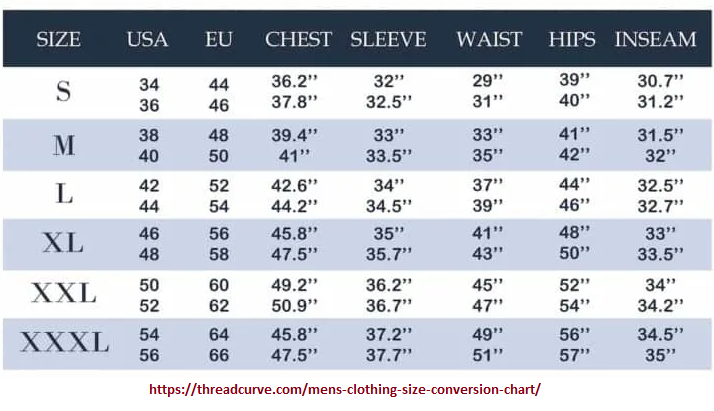
If one is not inclined to consider altnerative approaches to conventional ideas or apply conventional ideas to alternative approaches... preferring instead to play it safe and remain in the accepted and established parameters of consideration for a given research topic, then the blazing of new trails may have to depend on serendipity or various other types of accidental gain. Every single subject (serious or not), be it chemistry, astronomy, physics, mathematics, gaming, industry, technology, biology, criminology, animal husbandry, medicine, dentistry, surgery, etc., were established by ideas that may well in present perceptions be defined as superstition, silly, quackery, erroneous, buffonery, or just plain stupid and wrong. Sometimes humanity gets lucky and has a geniunely inspirational idea which appears to be provisionally insiteful, without need for much modification. At other times ideas must go through a laborious hit and miss travailing process before a useful view arises. Hence, those who are not afraid to speculate and say "what-if?", are more apt to continue pursuing a line of thinking that others fear will be too problematic or require too much sacrifice. So let us continue speculating.
If we take the history of the horse into consideration since it is well documented, the earlier variations were small and might well be termed dwarfs, though we of today are not inclined to used such a label. Developmental conditions over long expanses of time permitted and exercised an influence on the horse to develop into the giants of today (when compared to the small statures of old). Even though one might prefer to claim the Clydesdale breed of horses as expressions of gigantism, we do not look at the entire linneage of horse development in terms of a small- medium- large model of categorization. Likewise, we do not customarily view the development of a life form as beginning in a stage of dwarfism and then proceed towards a state of normalcy and perhaps gigantism. Cell development is not routinely looked at in a small to medium to large size, though we could include the triple X's to the small and large sizes to account for smaller and larger than common sizes. Cellular activity exhibits the same types of growth parameters we see in different species, and thus should include chromosomal counts in this same perspective. There are small counts and there are very large counts, each of which may have a similar originating influence modified over time by experential environmental conditions. Some biological activity may be more receptive to given environmental conditions than others, and be viewed by those who are unknowingly experiencing a condition undergoing a transition which tilts research data into a consternating appearance that is not replicatable by others whose own research efforts see later develpmental effects but not the transitioning ones.
Needless to say, perception is a big deal in developing any discipline, but in thinking about patterns within one subject or across the terrains of two or multiple subjects, we need to establish the view that when discussing patterns in Evolution such as this site (by using the Google query: "Patterns in evolution"): What are the 7 patterns of evolution? The site is of interest to me because of its inclination to use multiple enumerated references. However, if we intentionally use a googled query of "Numerical patterns in Evolution", we come up with various citations involving the Fibonacci sequence and others which view such a question involving the dichtomy of randomness and determined, with some including the addition of bias attached to one or both views. Yet, what is overlooked is the perspective that what we are paying witness to is the patterns being used by human to observe and catalogue that which is being labeled as Evolution. No less, if we were to enumerate all the patterns, it appears that we would be confronted with the repetition of only a few enumerated patterns which might well incline us to consider that we are being subjected to pressures enforcing a conservation, as a survival pattern in an incrementally deteriorating environment whose resources for multiple life forms, is dwindling.
What if the large chromosome count of some organisms is part of a larger puzzle not directly connected to the chromosme count of primates who developed during a time when the rotation rate of the Earth was conducive towards influencing primate development in concert with a given axial tilt of the earth, Since we are dealing with a doubling effect in chromosomes (half from each parent), the idea of polarization occurring in cells comes to mind as well as environmental instances of polariaztion such as the geomagnetic flip-flopping of the Earth as a possible developmental influence. If there is a chromosome/axial Earth tilt connection and the presence of large chromosome counts exceeds even a 360 degree tilt, we have to account for the differences as being due to some other variable such as the increased rotation rate of the Earth and oxygenation differences. Whereas the rotation rate during early primate and proto-primate developments may have been faster than today's 23 hours, 4 min.+ rate, (22+ hours), this increased centrifugal effect coupled to a different axial tilt, may be interacting effects particularly influential to particular species. If chromosomes portray a unique protein structure (like species-specific proteins of sperm and respective eggs), an entrainment to particular environmental cues may have proceeded into a 23 hour rotation rate period (from a faster 22 hour rate in the distant past)... when coupled to a 23 degree axial tilt. If such environmental events can be used as measuring sticks, we need to establish the linear scale of influence that takes place for different species arising at different times at different periods. Indeed, while an environmental event can set a biological activity into play, does it continue to do so after the initial kick-start, and more to the point, will a change in the rotation rate coupled to a changing axial tilt affect furture organisms (including humans) different enough to create a new species?
Smaller and larger chromosome counts found in different life forms when compared to present day humans, is not particularly trouble-some of one thinks in terms of developmental scales involving when the establishment of cleavage limits and developmental directions became established. For example, on most occasions humans grow five digits on the hands and feet. When more show up or less (such as in cases of webbing caused by fusions), the reasons for such occurrences may not be all too clear, but they nonetheless occur. The idea of rarity need not govern our thinking, as we do when we look at child prodigys or geniuses. Environmental conditions (such as rules, regulations, laws, requirements, nutritional standards, etc...) which are established by business, education systems, governments, religions (as well as smaller groups and singular self-impositions), can enforce types of expectations that may be labeled normalcy, and thus prove to be detours, stumbling blocks, and dead ends for a more natural developmental course where child prodgies and geniuses would be the norm and not the exception. But layering and constraints by way of a duplication along a triplicity appears to be the norm in many cases... unless such a scenario is little more than a rationalization on my part... conceived as a response to environmental circumstances which experentially repeat.
If a faster rotation rate of the Earth caused chromosomes to move loosely apart in concert with an axial tilt that was larger (or smaller) than today's spread of 21-24 degrees, why then did only the number 2 chromosome fuse to create an overall 46 chromosome count for present day humans, down from a 48 count found in earlier born primates? Does primate physiology have an affinity to closely follow some environmental events more closely than other life forms? Whether or not the correlation is relevant, it provides another numerical index by which other enumerated patterns can be associated amongst the different timeline scales of different references which can be collated and placed into a successionary role of overall development processes... which includes the entire Universe. While frequency of occurrence can suggest some uniform regularity that we may confidently consider as a prominent feature; infrequent patterns such as those with larger time frams of occurrence may not hold as much sway in our opinion unless aligned with one or more events that we come to label as being an important link for referencing similar infrequent events taking place over long expanses of time, place, or even the sparsity of someone being their to observe and record events which may otherwise occur more frequently if an accurate record were kept with an appropriate level of referencing. Far too often humans are inclined to think of themselves as experts, as masters of this, that and another trade/subject, when in actuality we are novices, ametures and wanna-be wise and knowledgable characters on a given research stage.
An assortment of timeline illustrations will no doubt be helpful to some readers who are more visually inclined. It is unfortunate that most timelines that I have come across do not mention, muchless correlate the changing events of Earth's axial tilt, Earth's rotation rate, Solar expansion, Lunar recession, and mass extinction events (etc.,), at the same time in the same illustration. However, those illustrations which may show multiple variables, may well only show the variables in a given frame of reference customary to the typical parameters covered by most reserchers who limit themselves to similar criteria based on the presence of absence of a given (set of) questions. Then again, nor have I actually created an illustration which protrays the variables that I am speaking of. I have used the variable separately, but even the different illustrations with the different variables have not routinely been provided in the same venue. I have, however, made mention of them on separate occasions which should be combined... or at least artistically exhibited in the same venue, since we can not rely upon conventional artists to display such ideas in a gallery of art work... mainly because those who attend such art exhibits do not customarily focuse their intellectualizations towards such perceptions, since they are preoccupied with the socialized currencies of presumed practicality.
Let me start the line-up of illustrations with a representation of primate evoltionary groups with the caveat that many of the "branching" graphs being presented by those I am able to come across that are used by others, do not place the primates in the order of evolutionary arrival; since the original illustrator(s) were not oriented towards making correlation to other events, though it is customary to find connections being made with geological events. Correlating biological occurrences to geological events is a routinely used association which expresses the preoccupations of those in the past, which are being repeated by researchers of today. There is a standard thinking formula of equating everything to some geological time period, and then using geology to govern how one thinks about development in different contexts. Geology becomes an umbrella-like criteria with which we are to establish different mile-stones and formalized expectations of occurrence. One without the other is said to be a fluke or border on some science fiction-like event, possibly involving time travel or some extra-terrestrial visitation. Clearly we sometimes become set in our mental ways.
Use of a geological standard coupled to life events is so common that one must think everyone is merely copying everyone else and are rather fearful of attempting any other correlation, since it is not relevant to either their tunnel-visioned interest or the illustration is being used in a classroom setting where the minds' of students are supposed to wear blinders and think along the same lines in the same box without "coloring" (looking) outside the lines of routined conventions... as is so often the case in religion, business and politics... particularly when wanting to have a better government but fearful of looking beyound the standard nonsense being practiced.
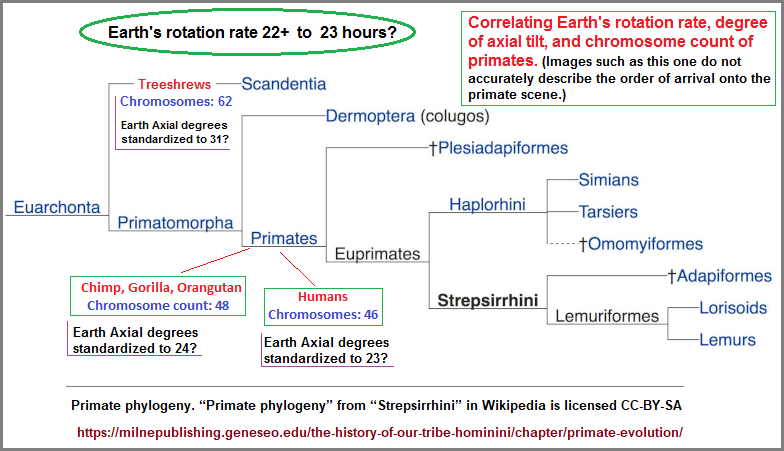
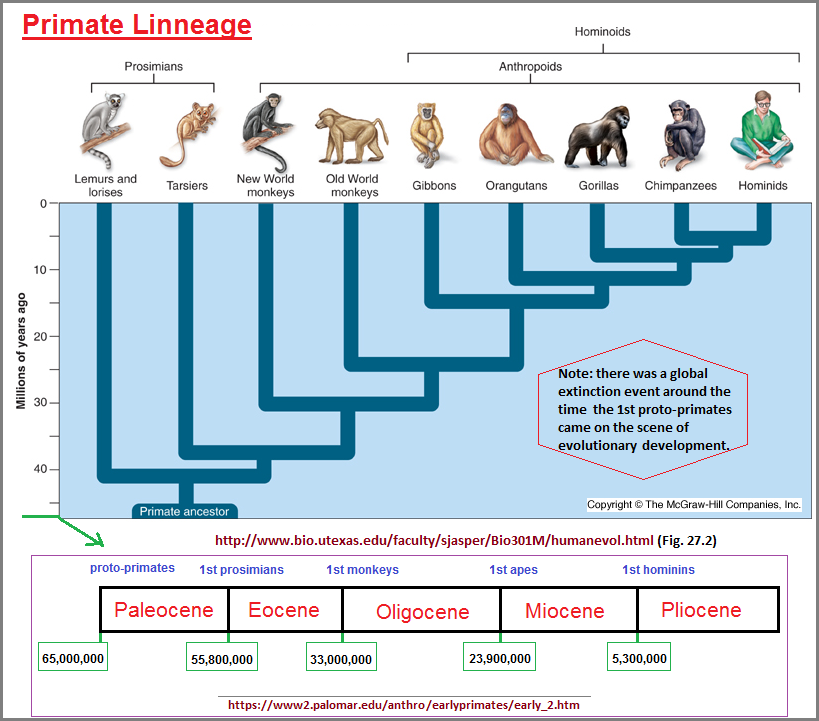
In the next image is an account of both earlier and later primate relations:
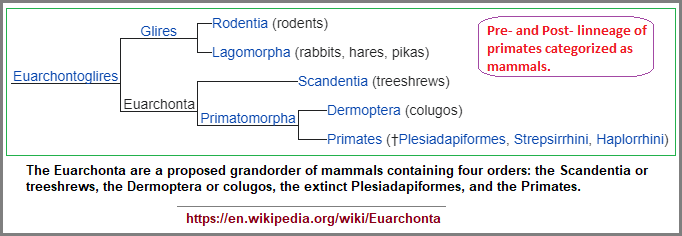
Yes, I know all the primates need to have a representative chromosome count placed in an evolutionary order so as to see whether or not there truly is a larger chromosomal count for those with an earlier ancestry when compared to humans. Of the three listed in the illustration, we find the following line-up:
- Tree-shrews arrived early and have a count of 62 chromosomes. This count needs to be correleated with the rotation rate of the Earth and the axial tilt. We also need to be mindful that the primate ancestory began somewhere during the 65 millions years ago era when the Earth experienced a great extinction, though other mass extinctions came prior to this event.
- Chimpanzees, Orangutangs, Apes (and other members of the Hominidae) have a count of 48 chromosomes. One must wonder if the axial tilt of the Earth was more on the order of a "stationary" 24 degree tilt as compared to the 23 degree tilt that humanity has been fit to record for its rather short existence. No less, the rate of the Earth's rotation during this time period has been in the 23 hour range, though during the threeshrew era of dominance, there may have been a 22+ hour rotation rate.
- Respective Human group (Neanderthal, Devonians, Cro-magnon, Present day humans) are said to have a 46 chromosome count.
Date of (series) Origination: Saturday, 14th March 2020... 6:11 AM
Date of Initial Posting: (this page) Monday, 28th February 2022... 11:55 AM